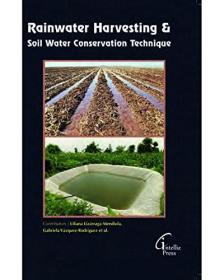
现货Rainwater Harvesting & Soil Water Conservation Technique[9781682511459]
¥ 1434 九五品
仅1件
上海宝山
认证卖家担保交易快速发货售后保障
作者Liliana Lizárraga-Mendiola, Gabriela Vázquez-Rodríguez et al.
出版社Intelliz Press LLC
ISBN9781682511459
出版时间2016-01
装帧精装
纸张其他
正文语种英语
上书时间2023-08-08
- 最新上架
商品详情
- 品相描述:九五品
- 商品描述
- Rainwater harvesting is the accumulation and deposition of rainwater for reuse on-site, rather than allowing it to run off. Rainwater can be collected from rivers or roofs, and in many places the water collected is redirected to a deep pit such as well, shaft, or borehole, a reservoir with percolation, or collected from dew or fog with nets or other tools. The text Rainwater Harvesting & Soil Water Conservation Technique presents the recent advances in water harvesting and also focuses on soil water conservation technique. There are always strong links between measures for soil conservation and measures for water conservation, and this applies equally in semi-arid areas. The objective of first chapter is to propose an estimation through which users can select a rainwater harvesting system for non-drinking water consumption. The goal of second chapter is to present an approach for designing garden variants that can be safely supplied with harvested rainwater, taking into account climate change and adaptation measures. Third chapter aims at assessing the impacts of climate change on rainwater harvesting systems (RWH) in the tropical urban city, Colombo, Sri Lanka. Fourth chapter investigates the benefit from a network of sharing RWHSs introducing different characteristics in water demand. Dimensionless analysis for designing domestic rainwater harvesting systems at the regional level in northern Taiwan has been focused in fifth chapter. The purpose of sixth chapter is to develop a set of universal definitions for potential domestic rainwater harvesting (DRWH) that can be used to quantify rainwater as a new obtainable water resource at national/regional levels. Seventh chapter investigates the performance of RWHS in peri-urban regions of Greater Sydney, Australia. Water vapor, temperature and wind profiles within maize canopy under in-field rainwater harvesting with wide and narrow runoff strips have been described in eighth chapter. Improved sustainability of water supply options in areas with arsenic-impacted groundwater has been discussed in ninth chapter. In tenth chapter, we propose an innovative method to move from the impact of RWH at the building level to larger and more complex scales. Eleventh chapter deals with future prospects for macro rainwater harvesting (RWH) technique in north east Iraq. The aim of twelfth chapter is to examine the interconnection between spatiotemporal distribution of the conducted cloud likelihood maps and clouds underneath terrain features to improve potential rainwater harvesting in the study area. The purpose of thirteenth chapter is to study how to increase rainwater consumption without discouraging farming. The role of weed and cover crops on soil and water conservation in a tropical region has been proposed in fourteenth chapter. Effects of soil and water conservation measures on groundwater levels and recharge have been investigated in fifteenth chapter. Alternative management practices for water conservation in dryland farming have been described in sixteenth chapter. In last chapter, we aim to corroborate the importance of sustainable land management (SLM) measures for Cape Verde, the strategies undertaken to address desertification, and the impact of those measures on the environment and rural livelihood.
— 没有更多了 —
![现货Rainwater Harvesting & Soil Water Conservation Technique[9781682511459]](https://www0.kfzimg.com/sw/kfz-cos/kfzimg/17733071/575e3e64bae4cf4a_b.jpg)

![现货Materials and Technologies of Modern Production[9783036401683]](https://www0.kfzimg.com/sw/kfz-cos/kfzimg/17733071/5fd2824531e165d7_s.jpg)
![现货Introduction to Container Ship Operations and Onboard Safety[9781032155425]](https://www0.kfzimg.com/sw/kfz-cos/kfzimg/17733071/58b7ff43ef7909ee_s.jpg)
![现货Electrophosphorescent Materials and Devices[9789814877343]](https://www0.kfzimg.com/sw/kfz-cos/kfzimg/17733071/18cc1d77bcb7b488_s.jpg)
![现货Organic Semiconductors for Optoelectronics[9781119146100]](https://www0.kfzimg.com/sw/kfz-cos/kfzimg/17733071/24c85a750c708964_s.jpg)
![现货Advances in Food Rheology and Its Applications[9780081004319]](https://www0.kfzimg.com/sw/kfz-cos/kfzimg/17733071/e0c11603c9119d4d_s.jpg)
![现货Advanced Materials and Sustainable Technologies[9783035727562]](https://www0.kfzimg.com/sw/kfz-cos/kfzimg/17733071/dced675333874c48_s.jpg)
![现货Advanced Materials and Manufacturing Engineering II[9783035712681]](https://www0.kfzimg.com/sw/kfz-cos/kfzimg/17733071/660ccfae75fa8d3e_s.jpg)
![现货Materials in Machinery and Construction[9783035718119]](https://www0.kfzimg.com/sw/kfz-cos/kfzimg/17733071/6f402060775e9daa_s.jpg)
![现货Cereal Grain Quality (Softcover Reprint of the Original 1st 1996)[9789401071772]](https://www0.kfzimg.com/sw/kfz-cos/kfzimg/17733071/f93ca1c96a97403a_s.jpg)
![现货Rainwater Harvesting & Soil Water Conservation Technique[9781682511459]](/dist/img/error.jpg)
以下为对购买帮助不大的评价